Finance for Managers: Cochlear Capital Structure and Capital Budgeting
VerifiedAdded on 2023/03/17
|20
|3030
|63
Report
AI Summary
This report provides a comprehensive financial analysis of Cochlear Limited, focusing on its capital structure and payout policies from 2016 to 2018. The analysis utilizes various financial ratios, including debt ratio, equity ratio, and dividend payout ratio, to evaluate the company's financial health and dividend distribution strategy. Additionally, the report includes a capital budgeting case study for OnePack Limited, evaluating a proposed commercial scale plant investment. The capital budgeting analysis employs net present value (NPV), internal rate of return (IRR), payback period, and profitability index to assess the project's feasibility, along with sensitivity analysis to account for different scenarios. Based on the findings, the report offers recommendations regarding the investment decision for OnePack Limited.
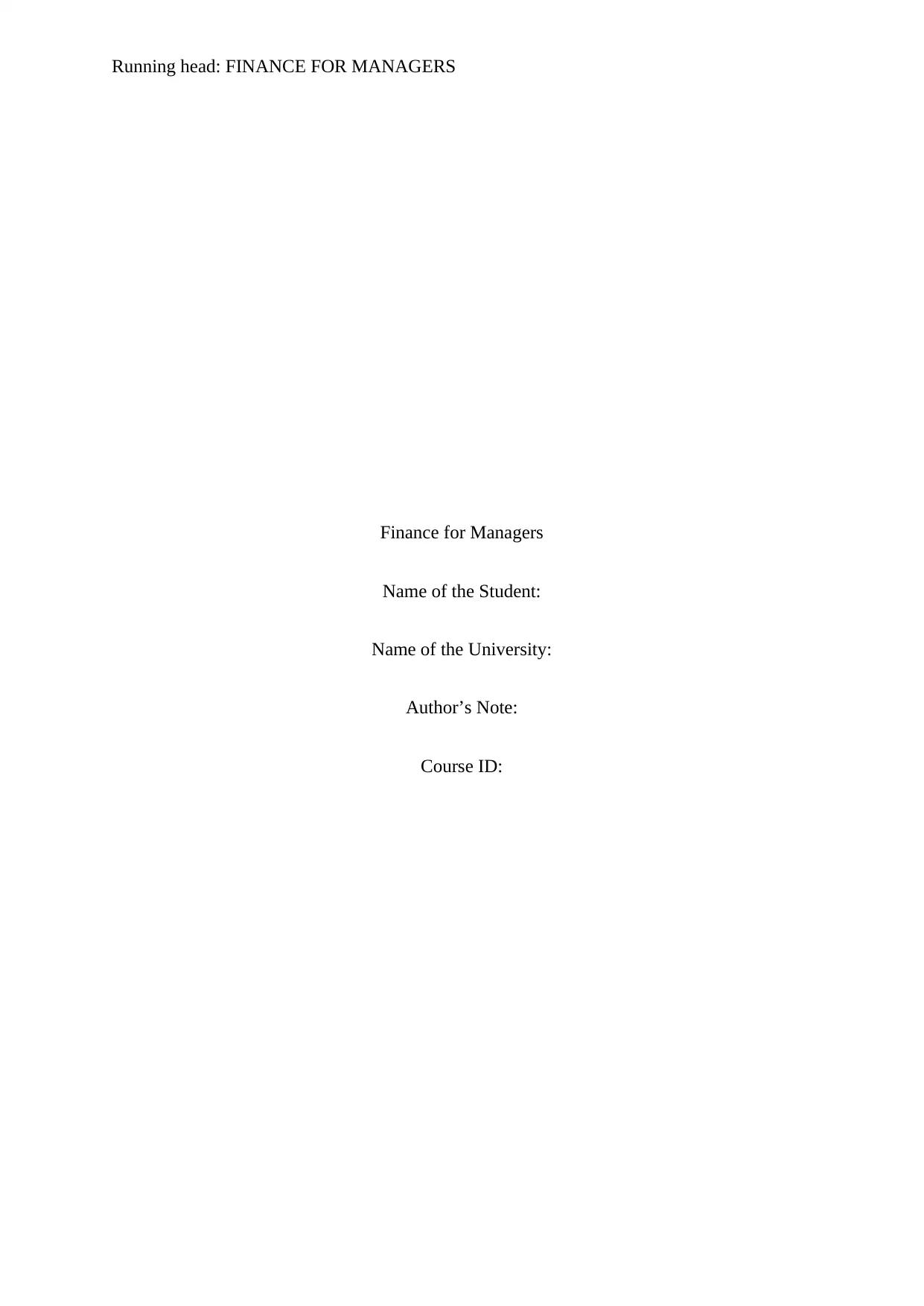
Running head: FINANCE FOR MANAGERS
Finance for Managers
Name of the Student:
Name of the University:
Author’s Note:
Course ID:
Finance for Managers
Name of the Student:
Name of the University:
Author’s Note:
Course ID:
Paraphrase This Document
Need a fresh take? Get an instant paraphrase of this document with our AI Paraphraser
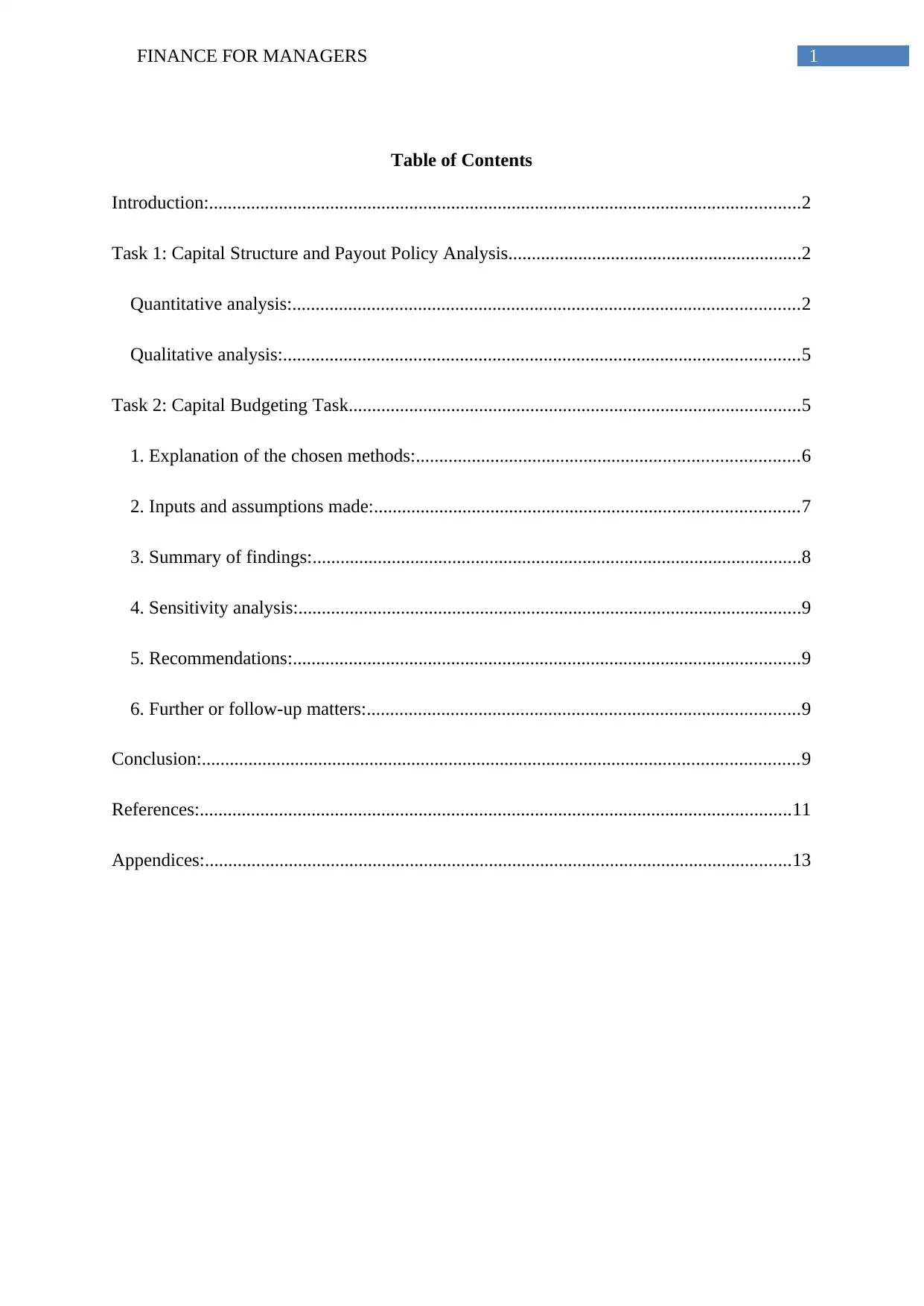
1FINANCE FOR MANAGERS
Table of Contents
Introduction:...............................................................................................................................2
Task 1: Capital Structure and Payout Policy Analysis...............................................................2
Quantitative analysis:.............................................................................................................2
Qualitative analysis:...............................................................................................................5
Task 2: Capital Budgeting Task.................................................................................................5
1. Explanation of the chosen methods:..................................................................................6
2. Inputs and assumptions made:...........................................................................................7
3. Summary of findings:.........................................................................................................8
4. Sensitivity analysis:............................................................................................................9
5. Recommendations:.............................................................................................................9
6. Further or follow-up matters:.............................................................................................9
Conclusion:................................................................................................................................9
References:...............................................................................................................................11
Appendices:..............................................................................................................................13
Table of Contents
Introduction:...............................................................................................................................2
Task 1: Capital Structure and Payout Policy Analysis...............................................................2
Quantitative analysis:.............................................................................................................2
Qualitative analysis:...............................................................................................................5
Task 2: Capital Budgeting Task.................................................................................................5
1. Explanation of the chosen methods:..................................................................................6
2. Inputs and assumptions made:...........................................................................................7
3. Summary of findings:.........................................................................................................8
4. Sensitivity analysis:............................................................................................................9
5. Recommendations:.............................................................................................................9
6. Further or follow-up matters:.............................................................................................9
Conclusion:................................................................................................................................9
References:...............................................................................................................................11
Appendices:..............................................................................................................................13
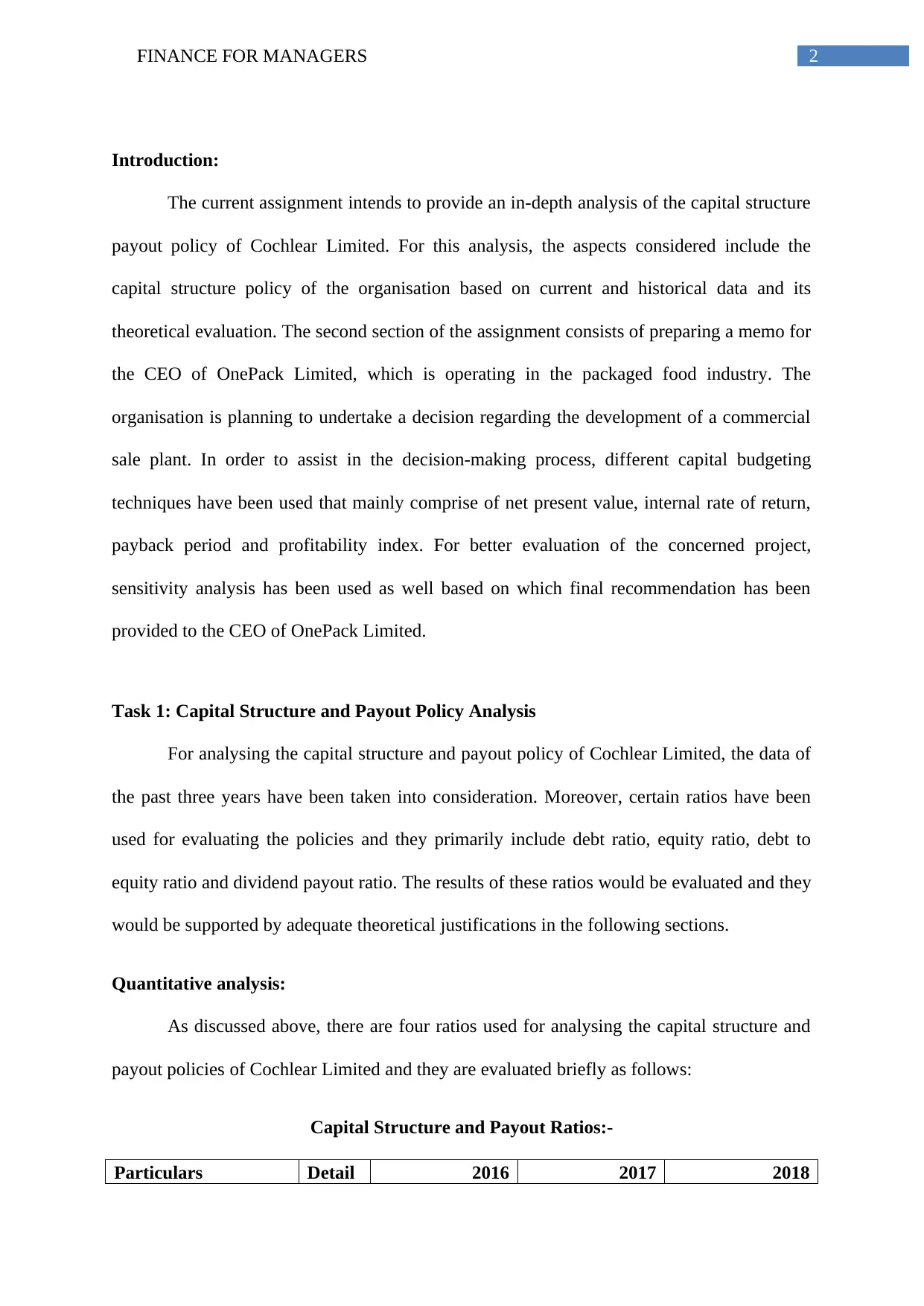
2FINANCE FOR MANAGERS
Introduction:
The current assignment intends to provide an in-depth analysis of the capital structure
payout policy of Cochlear Limited. For this analysis, the aspects considered include the
capital structure policy of the organisation based on current and historical data and its
theoretical evaluation. The second section of the assignment consists of preparing a memo for
the CEO of OnePack Limited, which is operating in the packaged food industry. The
organisation is planning to undertake a decision regarding the development of a commercial
sale plant. In order to assist in the decision-making process, different capital budgeting
techniques have been used that mainly comprise of net present value, internal rate of return,
payback period and profitability index. For better evaluation of the concerned project,
sensitivity analysis has been used as well based on which final recommendation has been
provided to the CEO of OnePack Limited.
Task 1: Capital Structure and Payout Policy Analysis
For analysing the capital structure and payout policy of Cochlear Limited, the data of
the past three years have been taken into consideration. Moreover, certain ratios have been
used for evaluating the policies and they primarily include debt ratio, equity ratio, debt to
equity ratio and dividend payout ratio. The results of these ratios would be evaluated and they
would be supported by adequate theoretical justifications in the following sections.
Quantitative analysis:
As discussed above, there are four ratios used for analysing the capital structure and
payout policies of Cochlear Limited and they are evaluated briefly as follows:
Capital Structure and Payout Ratios:-
Particulars Detail 2016 2017 2018
Introduction:
The current assignment intends to provide an in-depth analysis of the capital structure
payout policy of Cochlear Limited. For this analysis, the aspects considered include the
capital structure policy of the organisation based on current and historical data and its
theoretical evaluation. The second section of the assignment consists of preparing a memo for
the CEO of OnePack Limited, which is operating in the packaged food industry. The
organisation is planning to undertake a decision regarding the development of a commercial
sale plant. In order to assist in the decision-making process, different capital budgeting
techniques have been used that mainly comprise of net present value, internal rate of return,
payback period and profitability index. For better evaluation of the concerned project,
sensitivity analysis has been used as well based on which final recommendation has been
provided to the CEO of OnePack Limited.
Task 1: Capital Structure and Payout Policy Analysis
For analysing the capital structure and payout policy of Cochlear Limited, the data of
the past three years have been taken into consideration. Moreover, certain ratios have been
used for evaluating the policies and they primarily include debt ratio, equity ratio, debt to
equity ratio and dividend payout ratio. The results of these ratios would be evaluated and they
would be supported by adequate theoretical justifications in the following sections.
Quantitative analysis:
As discussed above, there are four ratios used for analysing the capital structure and
payout policies of Cochlear Limited and they are evaluated briefly as follows:
Capital Structure and Payout Ratios:-
Particulars Detail 2016 2017 2018
⊘ This is a preview!⊘
Do you want full access?
Subscribe today to unlock all pages.

Trusted by 1+ million students worldwide
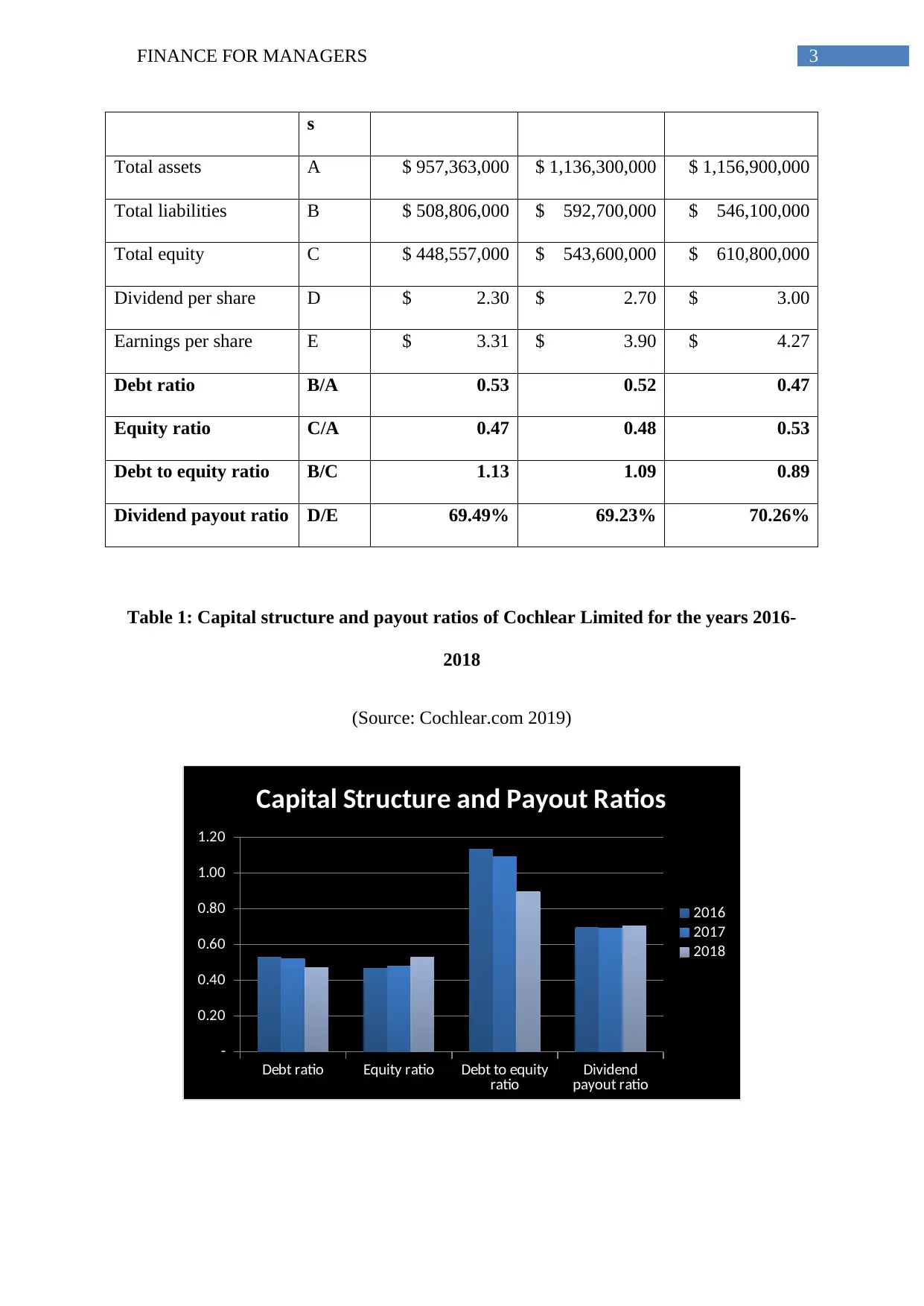
3FINANCE FOR MANAGERS
s
Total assets A $ 957,363,000 $ 1,136,300,000 $ 1,156,900,000
Total liabilities B $ 508,806,000 $ 592,700,000 $ 546,100,000
Total equity C $ 448,557,000 $ 543,600,000 $ 610,800,000
Dividend per share D $ 2.30 $ 2.70 $ 3.00
Earnings per share E $ 3.31 $ 3.90 $ 4.27
Debt ratio B/A 0.53 0.52 0.47
Equity ratio C/A 0.47 0.48 0.53
Debt to equity ratio B/C 1.13 1.09 0.89
Dividend payout ratio D/E 69.49% 69.23% 70.26%
Table 1: Capital structure and payout ratios of Cochlear Limited for the years 2016-
2018
(Source: Cochlear.com 2019)
Debt ratio Equity ratio Debt to equity
ratio Dividend
payout ratio
-
0.20
0.40
0.60
0.80
1.00
1.20
Capital Structure and Payout Ratios
2016
2017
2018
s
Total assets A $ 957,363,000 $ 1,136,300,000 $ 1,156,900,000
Total liabilities B $ 508,806,000 $ 592,700,000 $ 546,100,000
Total equity C $ 448,557,000 $ 543,600,000 $ 610,800,000
Dividend per share D $ 2.30 $ 2.70 $ 3.00
Earnings per share E $ 3.31 $ 3.90 $ 4.27
Debt ratio B/A 0.53 0.52 0.47
Equity ratio C/A 0.47 0.48 0.53
Debt to equity ratio B/C 1.13 1.09 0.89
Dividend payout ratio D/E 69.49% 69.23% 70.26%
Table 1: Capital structure and payout ratios of Cochlear Limited for the years 2016-
2018
(Source: Cochlear.com 2019)
Debt ratio Equity ratio Debt to equity
ratio Dividend
payout ratio
-
0.20
0.40
0.60
0.80
1.00
1.20
Capital Structure and Payout Ratios
2016
2017
2018
Paraphrase This Document
Need a fresh take? Get an instant paraphrase of this document with our AI Paraphraser
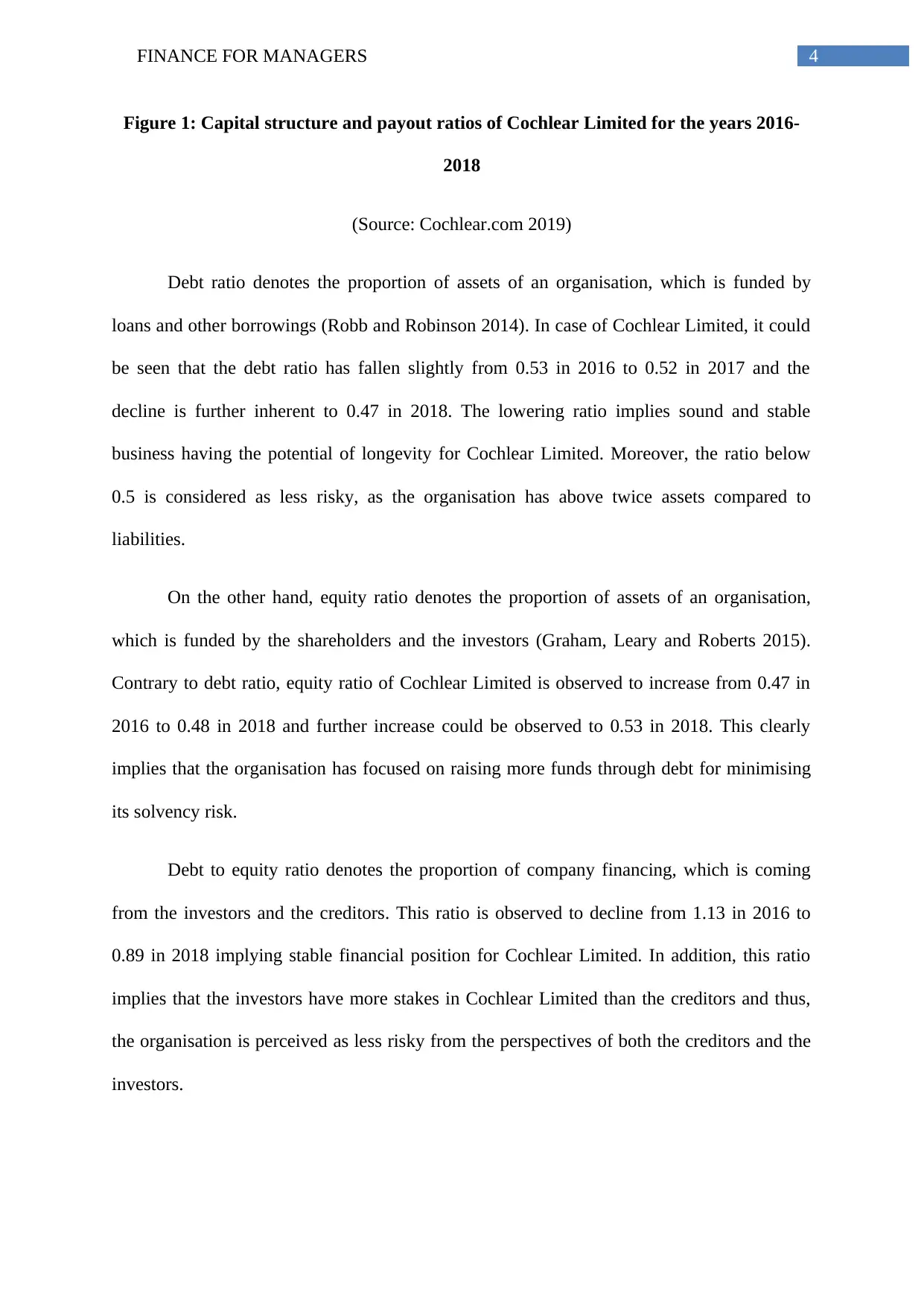
4FINANCE FOR MANAGERS
Figure 1: Capital structure and payout ratios of Cochlear Limited for the years 2016-
2018
(Source: Cochlear.com 2019)
Debt ratio denotes the proportion of assets of an organisation, which is funded by
loans and other borrowings (Robb and Robinson 2014). In case of Cochlear Limited, it could
be seen that the debt ratio has fallen slightly from 0.53 in 2016 to 0.52 in 2017 and the
decline is further inherent to 0.47 in 2018. The lowering ratio implies sound and stable
business having the potential of longevity for Cochlear Limited. Moreover, the ratio below
0.5 is considered as less risky, as the organisation has above twice assets compared to
liabilities.
On the other hand, equity ratio denotes the proportion of assets of an organisation,
which is funded by the shareholders and the investors (Graham, Leary and Roberts 2015).
Contrary to debt ratio, equity ratio of Cochlear Limited is observed to increase from 0.47 in
2016 to 0.48 in 2018 and further increase could be observed to 0.53 in 2018. This clearly
implies that the organisation has focused on raising more funds through debt for minimising
its solvency risk.
Debt to equity ratio denotes the proportion of company financing, which is coming
from the investors and the creditors. This ratio is observed to decline from 1.13 in 2016 to
0.89 in 2018 implying stable financial position for Cochlear Limited. In addition, this ratio
implies that the investors have more stakes in Cochlear Limited than the creditors and thus,
the organisation is perceived as less risky from the perspectives of both the creditors and the
investors.
Figure 1: Capital structure and payout ratios of Cochlear Limited for the years 2016-
2018
(Source: Cochlear.com 2019)
Debt ratio denotes the proportion of assets of an organisation, which is funded by
loans and other borrowings (Robb and Robinson 2014). In case of Cochlear Limited, it could
be seen that the debt ratio has fallen slightly from 0.53 in 2016 to 0.52 in 2017 and the
decline is further inherent to 0.47 in 2018. The lowering ratio implies sound and stable
business having the potential of longevity for Cochlear Limited. Moreover, the ratio below
0.5 is considered as less risky, as the organisation has above twice assets compared to
liabilities.
On the other hand, equity ratio denotes the proportion of assets of an organisation,
which is funded by the shareholders and the investors (Graham, Leary and Roberts 2015).
Contrary to debt ratio, equity ratio of Cochlear Limited is observed to increase from 0.47 in
2016 to 0.48 in 2018 and further increase could be observed to 0.53 in 2018. This clearly
implies that the organisation has focused on raising more funds through debt for minimising
its solvency risk.
Debt to equity ratio denotes the proportion of company financing, which is coming
from the investors and the creditors. This ratio is observed to decline from 1.13 in 2016 to
0.89 in 2018 implying stable financial position for Cochlear Limited. In addition, this ratio
implies that the investors have more stakes in Cochlear Limited than the creditors and thus,
the organisation is perceived as less risky from the perspectives of both the creditors and the
investors.
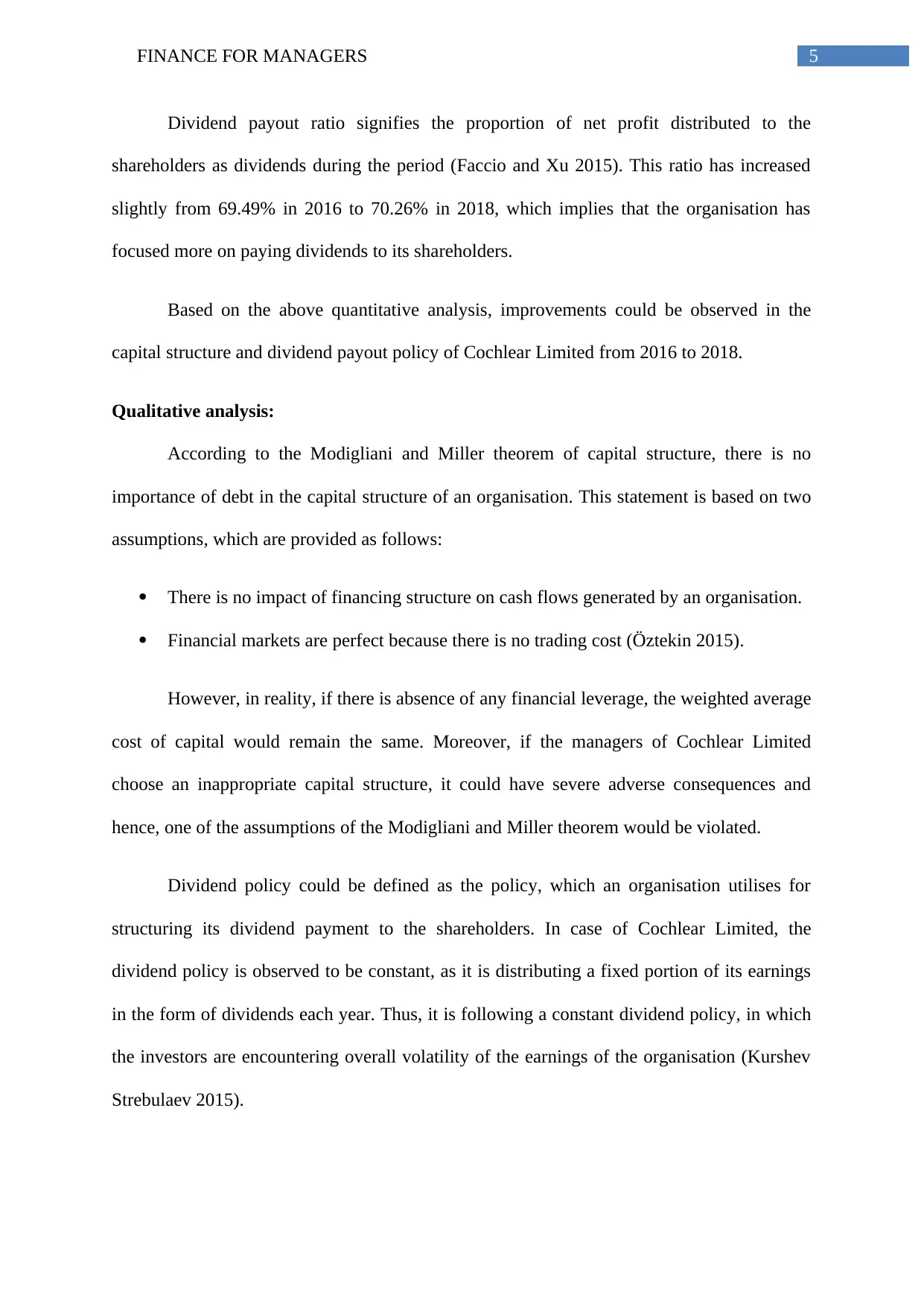
5FINANCE FOR MANAGERS
Dividend payout ratio signifies the proportion of net profit distributed to the
shareholders as dividends during the period (Faccio and Xu 2015). This ratio has increased
slightly from 69.49% in 2016 to 70.26% in 2018, which implies that the organisation has
focused more on paying dividends to its shareholders.
Based on the above quantitative analysis, improvements could be observed in the
capital structure and dividend payout policy of Cochlear Limited from 2016 to 2018.
Qualitative analysis:
According to the Modigliani and Miller theorem of capital structure, there is no
importance of debt in the capital structure of an organisation. This statement is based on two
assumptions, which are provided as follows:
There is no impact of financing structure on cash flows generated by an organisation.
Financial markets are perfect because there is no trading cost (Öztekin 2015).
However, in reality, if there is absence of any financial leverage, the weighted average
cost of capital would remain the same. Moreover, if the managers of Cochlear Limited
choose an inappropriate capital structure, it could have severe adverse consequences and
hence, one of the assumptions of the Modigliani and Miller theorem would be violated.
Dividend policy could be defined as the policy, which an organisation utilises for
structuring its dividend payment to the shareholders. In case of Cochlear Limited, the
dividend policy is observed to be constant, as it is distributing a fixed portion of its earnings
in the form of dividends each year. Thus, it is following a constant dividend policy, in which
the investors are encountering overall volatility of the earnings of the organisation (Kurshev
Strebulaev 2015).
Dividend payout ratio signifies the proportion of net profit distributed to the
shareholders as dividends during the period (Faccio and Xu 2015). This ratio has increased
slightly from 69.49% in 2016 to 70.26% in 2018, which implies that the organisation has
focused more on paying dividends to its shareholders.
Based on the above quantitative analysis, improvements could be observed in the
capital structure and dividend payout policy of Cochlear Limited from 2016 to 2018.
Qualitative analysis:
According to the Modigliani and Miller theorem of capital structure, there is no
importance of debt in the capital structure of an organisation. This statement is based on two
assumptions, which are provided as follows:
There is no impact of financing structure on cash flows generated by an organisation.
Financial markets are perfect because there is no trading cost (Öztekin 2015).
However, in reality, if there is absence of any financial leverage, the weighted average
cost of capital would remain the same. Moreover, if the managers of Cochlear Limited
choose an inappropriate capital structure, it could have severe adverse consequences and
hence, one of the assumptions of the Modigliani and Miller theorem would be violated.
Dividend policy could be defined as the policy, which an organisation utilises for
structuring its dividend payment to the shareholders. In case of Cochlear Limited, the
dividend policy is observed to be constant, as it is distributing a fixed portion of its earnings
in the form of dividends each year. Thus, it is following a constant dividend policy, in which
the investors are encountering overall volatility of the earnings of the organisation (Kurshev
Strebulaev 2015).
⊘ This is a preview!⊘
Do you want full access?
Subscribe today to unlock all pages.

Trusted by 1+ million students worldwide
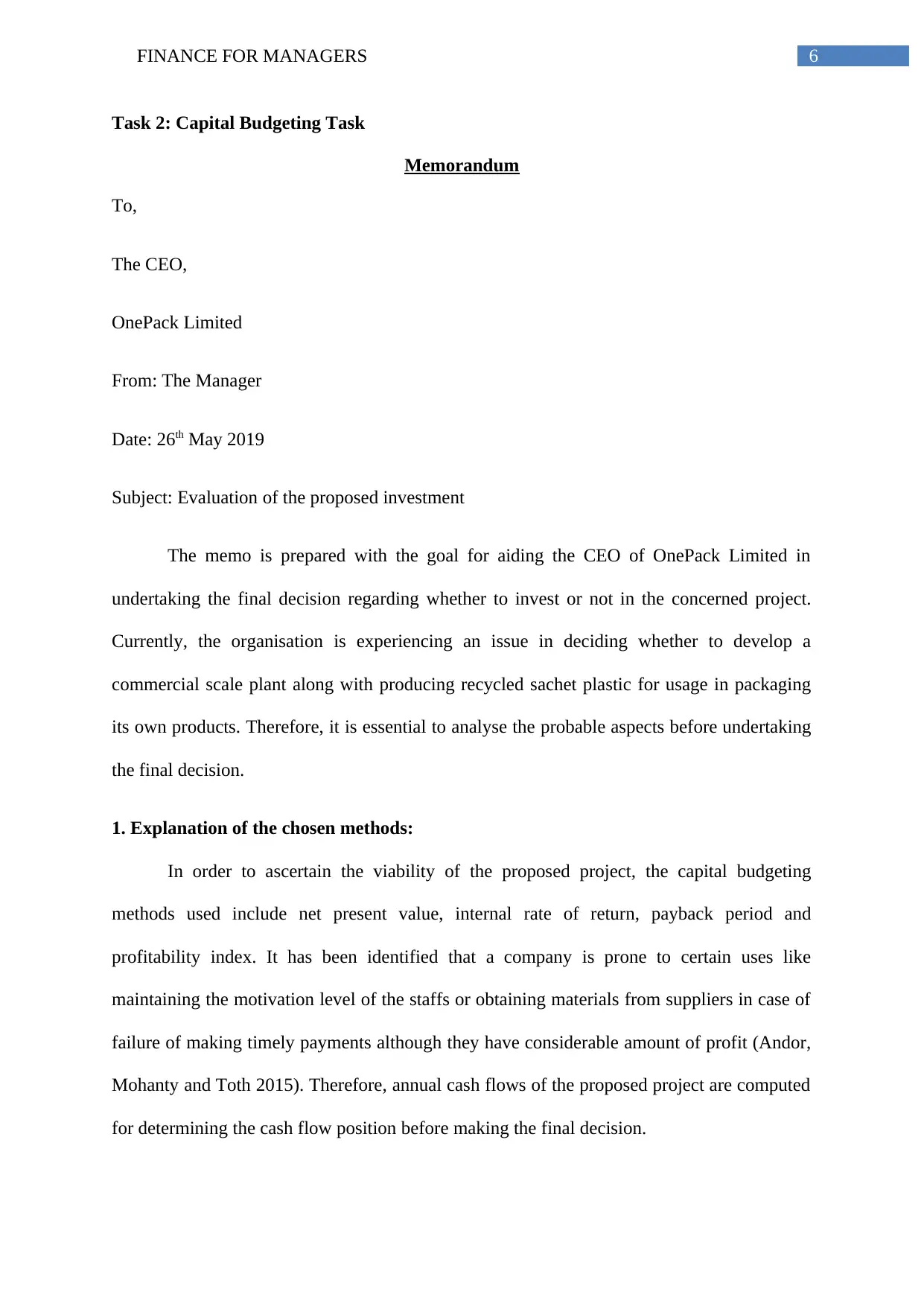
6FINANCE FOR MANAGERS
Task 2: Capital Budgeting Task
Memorandum
To,
The CEO,
OnePack Limited
From: The Manager
Date: 26th May 2019
Subject: Evaluation of the proposed investment
The memo is prepared with the goal for aiding the CEO of OnePack Limited in
undertaking the final decision regarding whether to invest or not in the concerned project.
Currently, the organisation is experiencing an issue in deciding whether to develop a
commercial scale plant along with producing recycled sachet plastic for usage in packaging
its own products. Therefore, it is essential to analyse the probable aspects before undertaking
the final decision.
1. Explanation of the chosen methods:
In order to ascertain the viability of the proposed project, the capital budgeting
methods used include net present value, internal rate of return, payback period and
profitability index. It has been identified that a company is prone to certain uses like
maintaining the motivation level of the staffs or obtaining materials from suppliers in case of
failure of making timely payments although they have considerable amount of profit (Andor,
Mohanty and Toth 2015). Therefore, annual cash flows of the proposed project are computed
for determining the cash flow position before making the final decision.
Task 2: Capital Budgeting Task
Memorandum
To,
The CEO,
OnePack Limited
From: The Manager
Date: 26th May 2019
Subject: Evaluation of the proposed investment
The memo is prepared with the goal for aiding the CEO of OnePack Limited in
undertaking the final decision regarding whether to invest or not in the concerned project.
Currently, the organisation is experiencing an issue in deciding whether to develop a
commercial scale plant along with producing recycled sachet plastic for usage in packaging
its own products. Therefore, it is essential to analyse the probable aspects before undertaking
the final decision.
1. Explanation of the chosen methods:
In order to ascertain the viability of the proposed project, the capital budgeting
methods used include net present value, internal rate of return, payback period and
profitability index. It has been identified that a company is prone to certain uses like
maintaining the motivation level of the staffs or obtaining materials from suppliers in case of
failure of making timely payments although they have considerable amount of profit (Andor,
Mohanty and Toth 2015). Therefore, annual cash flows of the proposed project are computed
for determining the cash flow position before making the final decision.
Paraphrase This Document
Need a fresh take? Get an instant paraphrase of this document with our AI Paraphraser
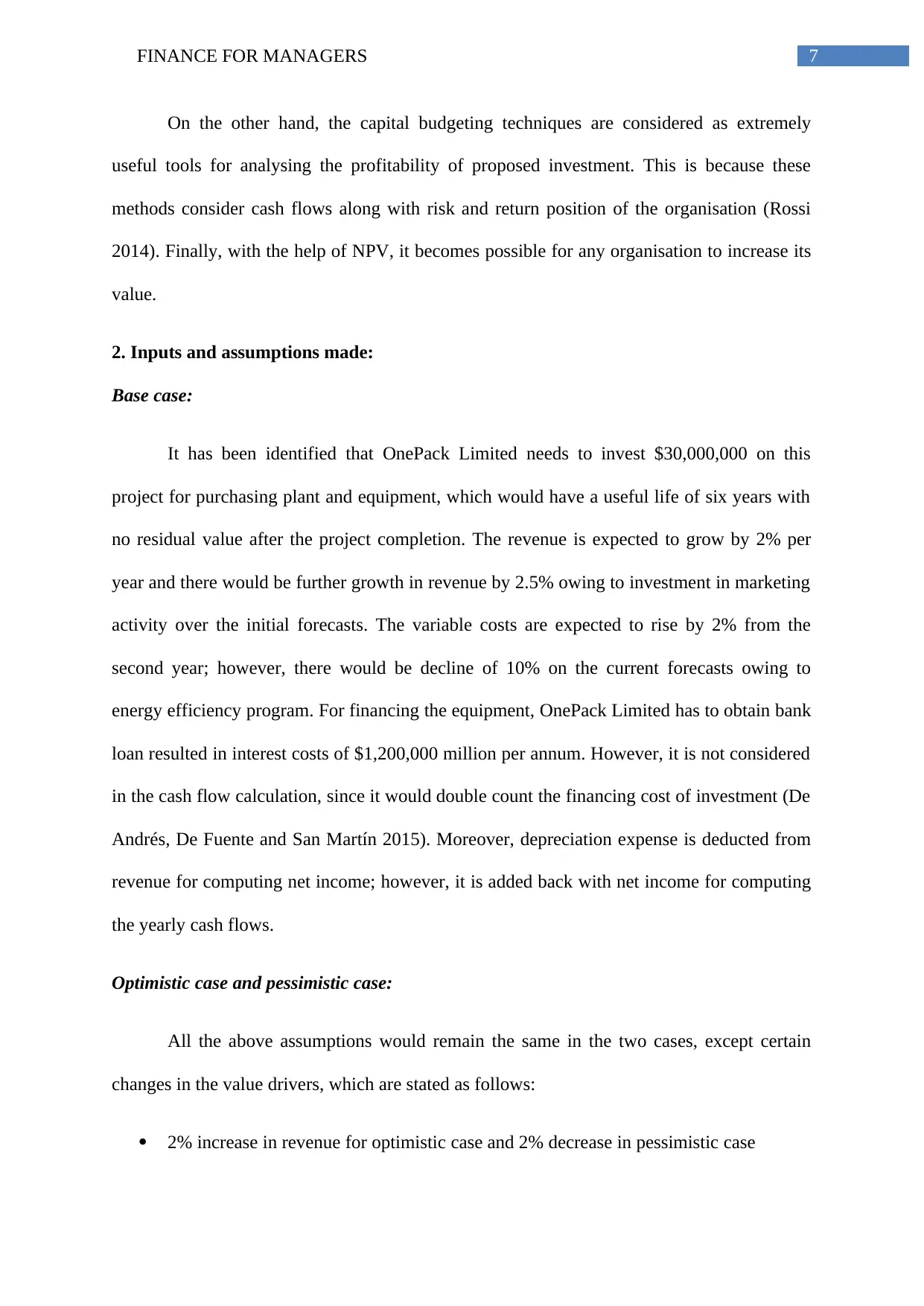
7FINANCE FOR MANAGERS
On the other hand, the capital budgeting techniques are considered as extremely
useful tools for analysing the profitability of proposed investment. This is because these
methods consider cash flows along with risk and return position of the organisation (Rossi
2014). Finally, with the help of NPV, it becomes possible for any organisation to increase its
value.
2. Inputs and assumptions made:
Base case:
It has been identified that OnePack Limited needs to invest $30,000,000 on this
project for purchasing plant and equipment, which would have a useful life of six years with
no residual value after the project completion. The revenue is expected to grow by 2% per
year and there would be further growth in revenue by 2.5% owing to investment in marketing
activity over the initial forecasts. The variable costs are expected to rise by 2% from the
second year; however, there would be decline of 10% on the current forecasts owing to
energy efficiency program. For financing the equipment, OnePack Limited has to obtain bank
loan resulted in interest costs of $1,200,000 million per annum. However, it is not considered
in the cash flow calculation, since it would double count the financing cost of investment (De
Andrés, De Fuente and San Martín 2015). Moreover, depreciation expense is deducted from
revenue for computing net income; however, it is added back with net income for computing
the yearly cash flows.
Optimistic case and pessimistic case:
All the above assumptions would remain the same in the two cases, except certain
changes in the value drivers, which are stated as follows:
2% increase in revenue for optimistic case and 2% decrease in pessimistic case
On the other hand, the capital budgeting techniques are considered as extremely
useful tools for analysing the profitability of proposed investment. This is because these
methods consider cash flows along with risk and return position of the organisation (Rossi
2014). Finally, with the help of NPV, it becomes possible for any organisation to increase its
value.
2. Inputs and assumptions made:
Base case:
It has been identified that OnePack Limited needs to invest $30,000,000 on this
project for purchasing plant and equipment, which would have a useful life of six years with
no residual value after the project completion. The revenue is expected to grow by 2% per
year and there would be further growth in revenue by 2.5% owing to investment in marketing
activity over the initial forecasts. The variable costs are expected to rise by 2% from the
second year; however, there would be decline of 10% on the current forecasts owing to
energy efficiency program. For financing the equipment, OnePack Limited has to obtain bank
loan resulted in interest costs of $1,200,000 million per annum. However, it is not considered
in the cash flow calculation, since it would double count the financing cost of investment (De
Andrés, De Fuente and San Martín 2015). Moreover, depreciation expense is deducted from
revenue for computing net income; however, it is added back with net income for computing
the yearly cash flows.
Optimistic case and pessimistic case:
All the above assumptions would remain the same in the two cases, except certain
changes in the value drivers, which are stated as follows:
2% increase in revenue for optimistic case and 2% decrease in pessimistic case
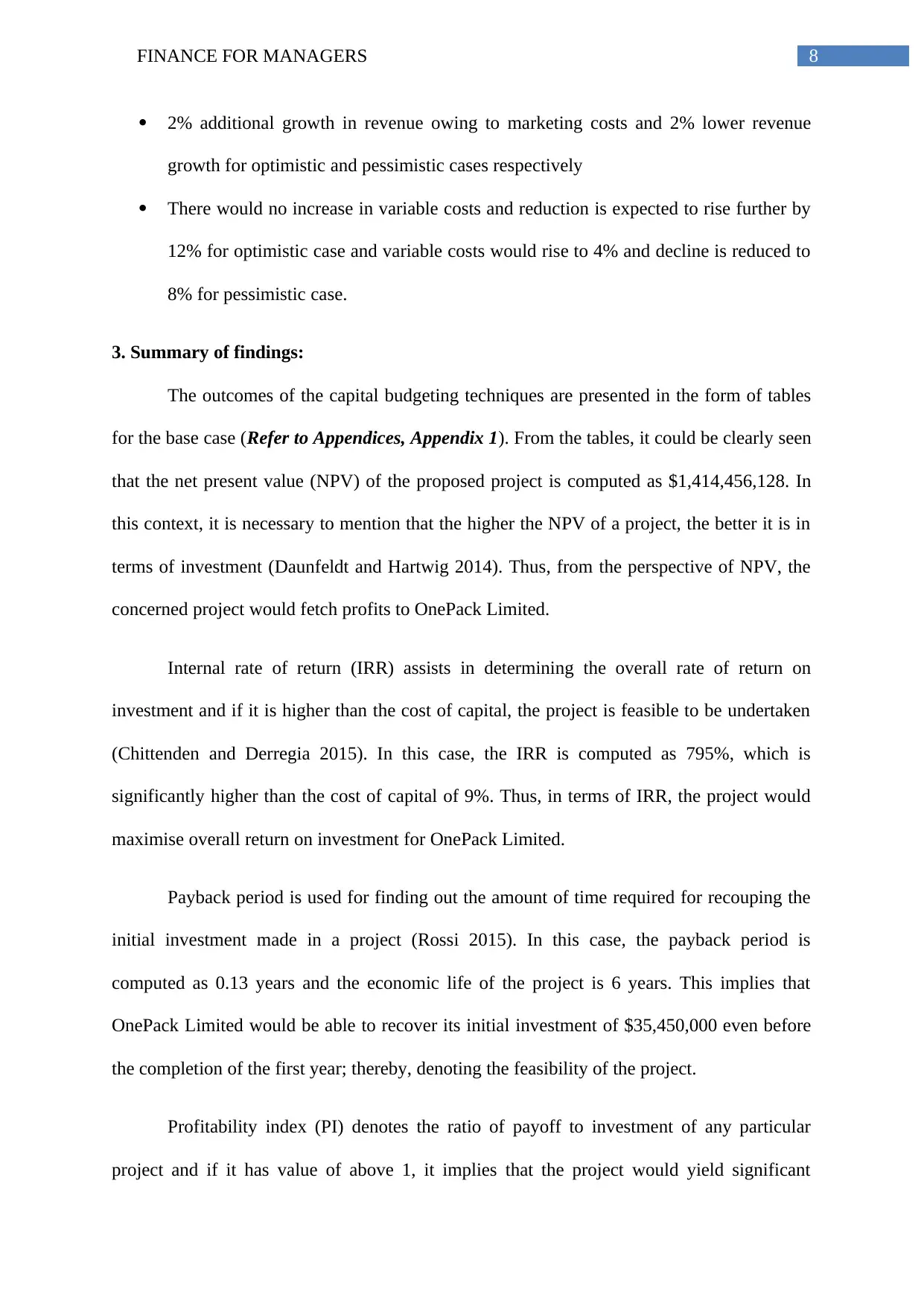
8FINANCE FOR MANAGERS
2% additional growth in revenue owing to marketing costs and 2% lower revenue
growth for optimistic and pessimistic cases respectively
There would no increase in variable costs and reduction is expected to rise further by
12% for optimistic case and variable costs would rise to 4% and decline is reduced to
8% for pessimistic case.
3. Summary of findings:
The outcomes of the capital budgeting techniques are presented in the form of tables
for the base case (Refer to Appendices, Appendix 1). From the tables, it could be clearly seen
that the net present value (NPV) of the proposed project is computed as $1,414,456,128. In
this context, it is necessary to mention that the higher the NPV of a project, the better it is in
terms of investment (Daunfeldt and Hartwig 2014). Thus, from the perspective of NPV, the
concerned project would fetch profits to OnePack Limited.
Internal rate of return (IRR) assists in determining the overall rate of return on
investment and if it is higher than the cost of capital, the project is feasible to be undertaken
(Chittenden and Derregia 2015). In this case, the IRR is computed as 795%, which is
significantly higher than the cost of capital of 9%. Thus, in terms of IRR, the project would
maximise overall return on investment for OnePack Limited.
Payback period is used for finding out the amount of time required for recouping the
initial investment made in a project (Rossi 2015). In this case, the payback period is
computed as 0.13 years and the economic life of the project is 6 years. This implies that
OnePack Limited would be able to recover its initial investment of $35,450,000 even before
the completion of the first year; thereby, denoting the feasibility of the project.
Profitability index (PI) denotes the ratio of payoff to investment of any particular
project and if it has value of above 1, it implies that the project would yield significant
2% additional growth in revenue owing to marketing costs and 2% lower revenue
growth for optimistic and pessimistic cases respectively
There would no increase in variable costs and reduction is expected to rise further by
12% for optimistic case and variable costs would rise to 4% and decline is reduced to
8% for pessimistic case.
3. Summary of findings:
The outcomes of the capital budgeting techniques are presented in the form of tables
for the base case (Refer to Appendices, Appendix 1). From the tables, it could be clearly seen
that the net present value (NPV) of the proposed project is computed as $1,414,456,128. In
this context, it is necessary to mention that the higher the NPV of a project, the better it is in
terms of investment (Daunfeldt and Hartwig 2014). Thus, from the perspective of NPV, the
concerned project would fetch profits to OnePack Limited.
Internal rate of return (IRR) assists in determining the overall rate of return on
investment and if it is higher than the cost of capital, the project is feasible to be undertaken
(Chittenden and Derregia 2015). In this case, the IRR is computed as 795%, which is
significantly higher than the cost of capital of 9%. Thus, in terms of IRR, the project would
maximise overall return on investment for OnePack Limited.
Payback period is used for finding out the amount of time required for recouping the
initial investment made in a project (Rossi 2015). In this case, the payback period is
computed as 0.13 years and the economic life of the project is 6 years. This implies that
OnePack Limited would be able to recover its initial investment of $35,450,000 even before
the completion of the first year; thereby, denoting the feasibility of the project.
Profitability index (PI) denotes the ratio of payoff to investment of any particular
project and if it has value of above 1, it implies that the project would yield significant
⊘ This is a preview!⊘
Do you want full access?
Subscribe today to unlock all pages.

Trusted by 1+ million students worldwide
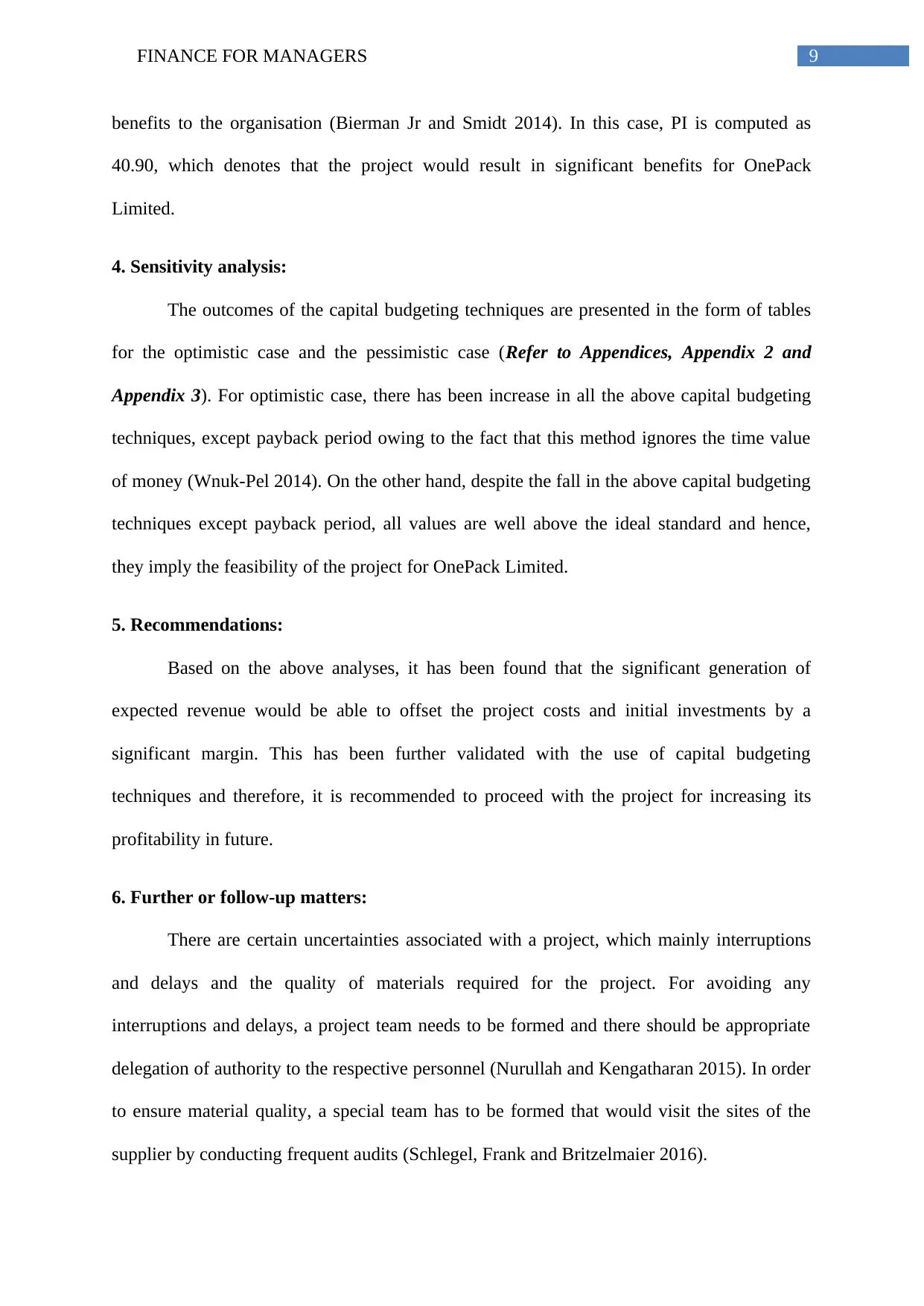
9FINANCE FOR MANAGERS
benefits to the organisation (Bierman Jr and Smidt 2014). In this case, PI is computed as
40.90, which denotes that the project would result in significant benefits for OnePack
Limited.
4. Sensitivity analysis:
The outcomes of the capital budgeting techniques are presented in the form of tables
for the optimistic case and the pessimistic case (Refer to Appendices, Appendix 2 and
Appendix 3). For optimistic case, there has been increase in all the above capital budgeting
techniques, except payback period owing to the fact that this method ignores the time value
of money (Wnuk-Pel 2014). On the other hand, despite the fall in the above capital budgeting
techniques except payback period, all values are well above the ideal standard and hence,
they imply the feasibility of the project for OnePack Limited.
5. Recommendations:
Based on the above analyses, it has been found that the significant generation of
expected revenue would be able to offset the project costs and initial investments by a
significant margin. This has been further validated with the use of capital budgeting
techniques and therefore, it is recommended to proceed with the project for increasing its
profitability in future.
6. Further or follow-up matters:
There are certain uncertainties associated with a project, which mainly interruptions
and delays and the quality of materials required for the project. For avoiding any
interruptions and delays, a project team needs to be formed and there should be appropriate
delegation of authority to the respective personnel (Nurullah and Kengatharan 2015). In order
to ensure material quality, a special team has to be formed that would visit the sites of the
supplier by conducting frequent audits (Schlegel, Frank and Britzelmaier 2016).
benefits to the organisation (Bierman Jr and Smidt 2014). In this case, PI is computed as
40.90, which denotes that the project would result in significant benefits for OnePack
Limited.
4. Sensitivity analysis:
The outcomes of the capital budgeting techniques are presented in the form of tables
for the optimistic case and the pessimistic case (Refer to Appendices, Appendix 2 and
Appendix 3). For optimistic case, there has been increase in all the above capital budgeting
techniques, except payback period owing to the fact that this method ignores the time value
of money (Wnuk-Pel 2014). On the other hand, despite the fall in the above capital budgeting
techniques except payback period, all values are well above the ideal standard and hence,
they imply the feasibility of the project for OnePack Limited.
5. Recommendations:
Based on the above analyses, it has been found that the significant generation of
expected revenue would be able to offset the project costs and initial investments by a
significant margin. This has been further validated with the use of capital budgeting
techniques and therefore, it is recommended to proceed with the project for increasing its
profitability in future.
6. Further or follow-up matters:
There are certain uncertainties associated with a project, which mainly interruptions
and delays and the quality of materials required for the project. For avoiding any
interruptions and delays, a project team needs to be formed and there should be appropriate
delegation of authority to the respective personnel (Nurullah and Kengatharan 2015). In order
to ensure material quality, a special team has to be formed that would visit the sites of the
supplier by conducting frequent audits (Schlegel, Frank and Britzelmaier 2016).
Paraphrase This Document
Need a fresh take? Get an instant paraphrase of this document with our AI Paraphraser
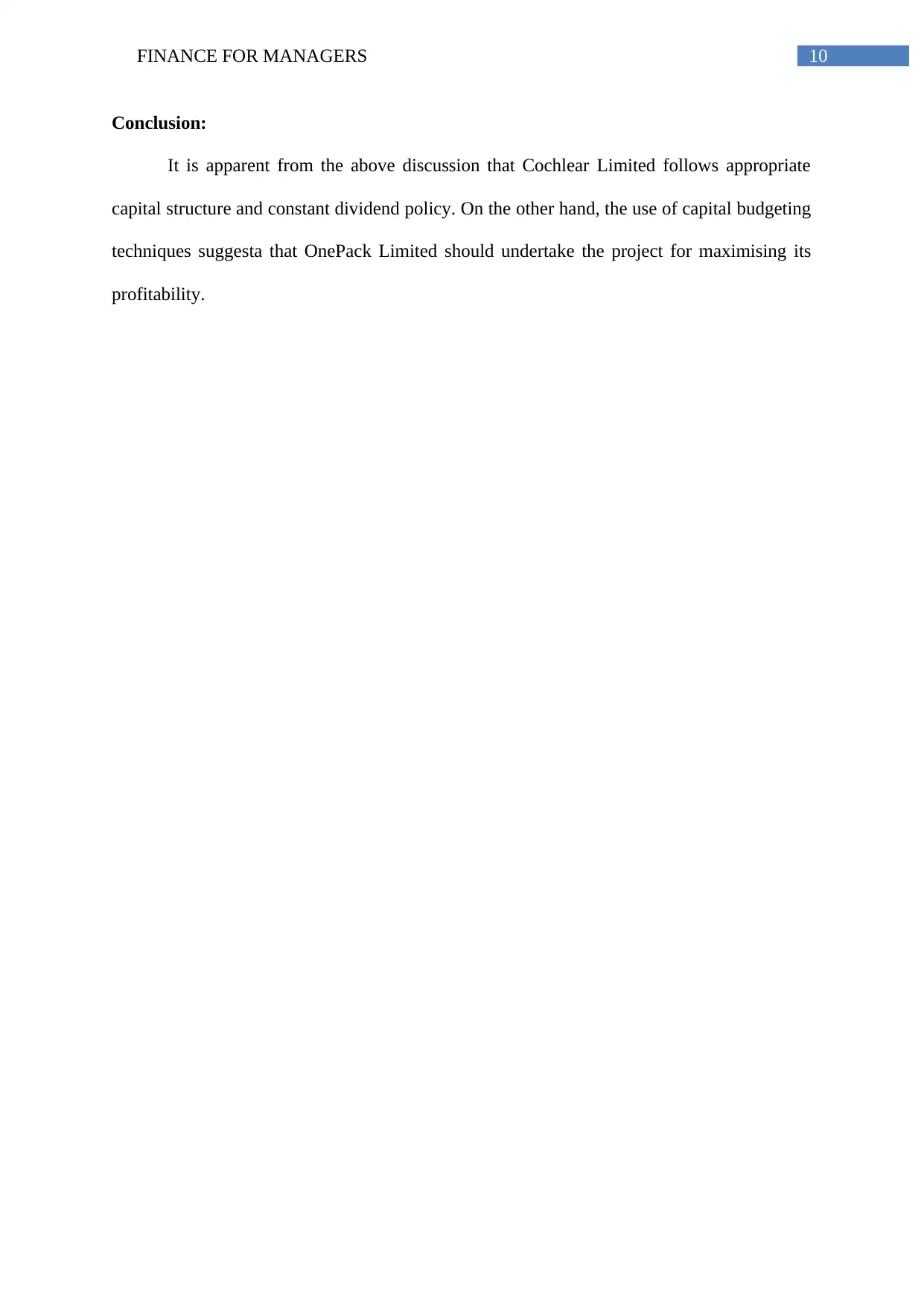
10FINANCE FOR MANAGERS
Conclusion:
It is apparent from the above discussion that Cochlear Limited follows appropriate
capital structure and constant dividend policy. On the other hand, the use of capital budgeting
techniques suggesta that OnePack Limited should undertake the project for maximising its
profitability.
Conclusion:
It is apparent from the above discussion that Cochlear Limited follows appropriate
capital structure and constant dividend policy. On the other hand, the use of capital budgeting
techniques suggesta that OnePack Limited should undertake the project for maximising its
profitability.
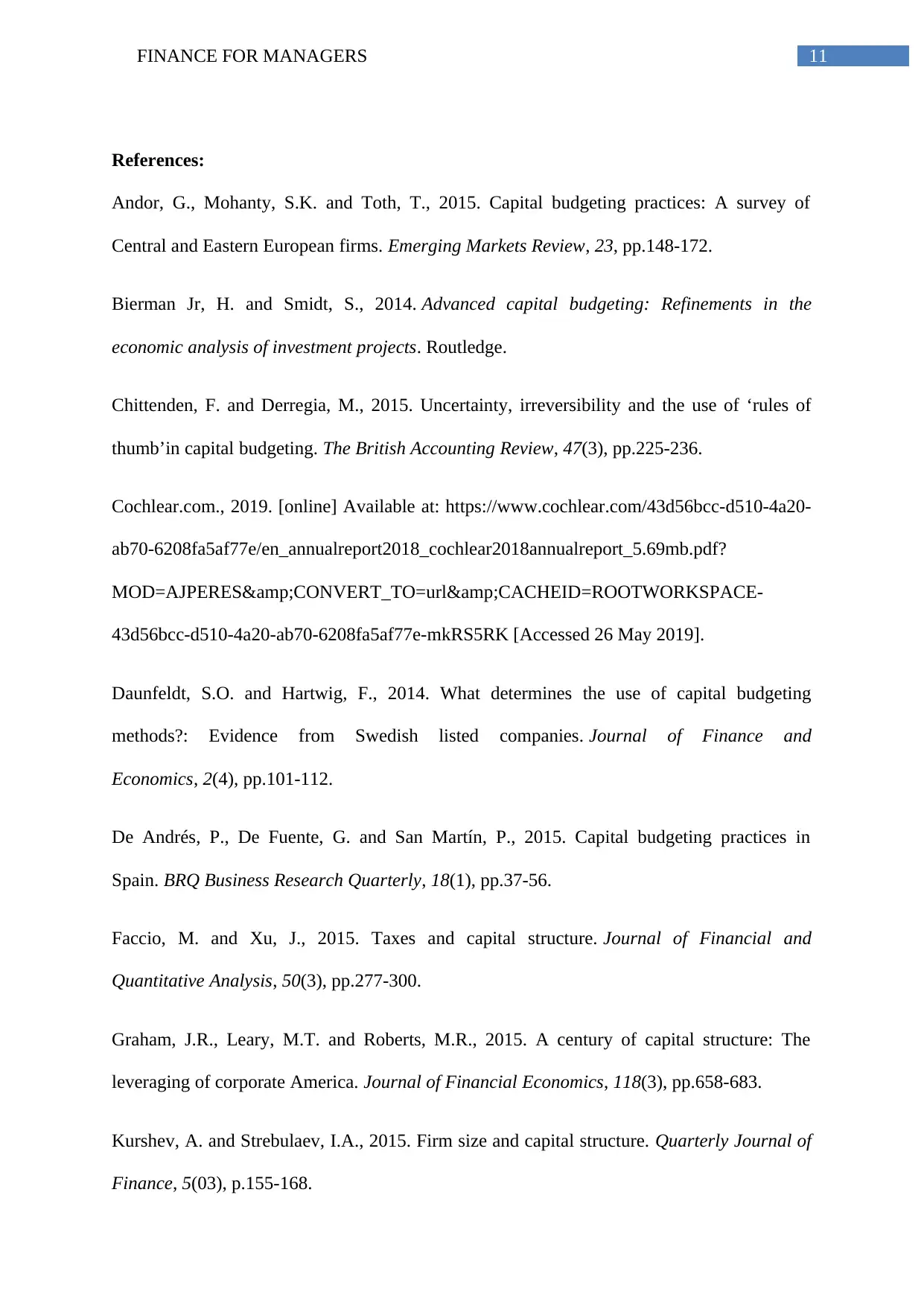
11FINANCE FOR MANAGERS
References:
Andor, G., Mohanty, S.K. and Toth, T., 2015. Capital budgeting practices: A survey of
Central and Eastern European firms. Emerging Markets Review, 23, pp.148-172.
Bierman Jr, H. and Smidt, S., 2014. Advanced capital budgeting: Refinements in the
economic analysis of investment projects. Routledge.
Chittenden, F. and Derregia, M., 2015. Uncertainty, irreversibility and the use of ‘rules of
thumb’in capital budgeting. The British Accounting Review, 47(3), pp.225-236.
Cochlear.com., 2019. [online] Available at: https://www.cochlear.com/43d56bcc-d510-4a20-
ab70-6208fa5af77e/en_annualreport2018_cochlear2018annualreport_5.69mb.pdf?
MOD=AJPERES&CONVERT_TO=url&CACHEID=ROOTWORKSPACE-
43d56bcc-d510-4a20-ab70-6208fa5af77e-mkRS5RK [Accessed 26 May 2019].
Daunfeldt, S.O. and Hartwig, F., 2014. What determines the use of capital budgeting
methods?: Evidence from Swedish listed companies. Journal of Finance and
Economics, 2(4), pp.101-112.
De Andrés, P., De Fuente, G. and San Martín, P., 2015. Capital budgeting practices in
Spain. BRQ Business Research Quarterly, 18(1), pp.37-56.
Faccio, M. and Xu, J., 2015. Taxes and capital structure. Journal of Financial and
Quantitative Analysis, 50(3), pp.277-300.
Graham, J.R., Leary, M.T. and Roberts, M.R., 2015. A century of capital structure: The
leveraging of corporate America. Journal of Financial Economics, 118(3), pp.658-683.
Kurshev, A. and Strebulaev, I.A., 2015. Firm size and capital structure. Quarterly Journal of
Finance, 5(03), p.155-168.
References:
Andor, G., Mohanty, S.K. and Toth, T., 2015. Capital budgeting practices: A survey of
Central and Eastern European firms. Emerging Markets Review, 23, pp.148-172.
Bierman Jr, H. and Smidt, S., 2014. Advanced capital budgeting: Refinements in the
economic analysis of investment projects. Routledge.
Chittenden, F. and Derregia, M., 2015. Uncertainty, irreversibility and the use of ‘rules of
thumb’in capital budgeting. The British Accounting Review, 47(3), pp.225-236.
Cochlear.com., 2019. [online] Available at: https://www.cochlear.com/43d56bcc-d510-4a20-
ab70-6208fa5af77e/en_annualreport2018_cochlear2018annualreport_5.69mb.pdf?
MOD=AJPERES&CONVERT_TO=url&CACHEID=ROOTWORKSPACE-
43d56bcc-d510-4a20-ab70-6208fa5af77e-mkRS5RK [Accessed 26 May 2019].
Daunfeldt, S.O. and Hartwig, F., 2014. What determines the use of capital budgeting
methods?: Evidence from Swedish listed companies. Journal of Finance and
Economics, 2(4), pp.101-112.
De Andrés, P., De Fuente, G. and San Martín, P., 2015. Capital budgeting practices in
Spain. BRQ Business Research Quarterly, 18(1), pp.37-56.
Faccio, M. and Xu, J., 2015. Taxes and capital structure. Journal of Financial and
Quantitative Analysis, 50(3), pp.277-300.
Graham, J.R., Leary, M.T. and Roberts, M.R., 2015. A century of capital structure: The
leveraging of corporate America. Journal of Financial Economics, 118(3), pp.658-683.
Kurshev, A. and Strebulaev, I.A., 2015. Firm size and capital structure. Quarterly Journal of
Finance, 5(03), p.155-168.
⊘ This is a preview!⊘
Do you want full access?
Subscribe today to unlock all pages.

Trusted by 1+ million students worldwide
1 out of 20
Related Documents
Your All-in-One AI-Powered Toolkit for Academic Success.
+13062052269
info@desklib.com
Available 24*7 on WhatsApp / Email
![[object Object]](/_next/static/media/star-bottom.7253800d.svg)
Unlock your academic potential
Copyright © 2020–2025 A2Z Services. All Rights Reserved. Developed and managed by ZUCOL.




